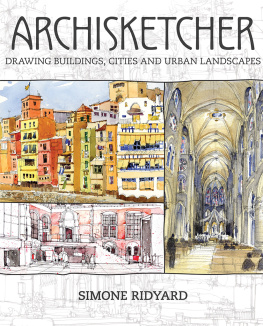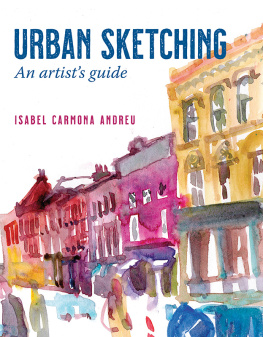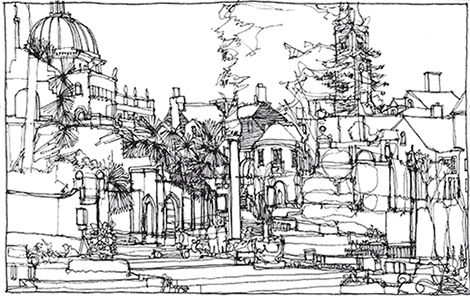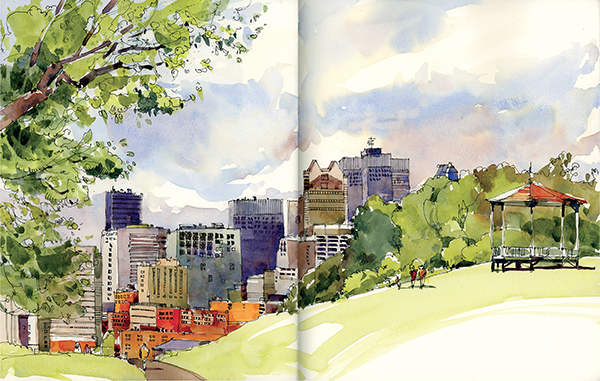Thank you for purchasing this Artist Network eBook.
Sign up for our newsletter and receive special offers, access to free content, and information on the latest new releases and must-have art resources! Plus, receive a coupon code to use on your first purchase from NorthLightShop.com for signing up.
or visit us online to sign up at
http://artistsnetwork.com/ebook-promo
Contents
CHAPTER ONE
CHAPTER TWO
CHAPTER THREE
CHAPTER FOUR
CHAPTER FIVE
CHAPTER SIX
Introduction
Increasingly people are taking to the streets and drawing. If youre sketching in urban environments, it is really important to have a basic understanding of how to draw architectureor at least the first principles involved in architectural sketching. You dont need to know the intricate details of perspective, composition or color theory; you just need to observe whats in front of you and draw it as best you can. Most of all, enjoy the experience and your enthusiasm will be reflected in what you sketch.
If you are serious about sketching, with practice your drawings will continue to improve and, even more importantly, you will develop your own personal style. Many of the sketchers featured in this book have spent years refining their unique approach, and its always such a pleasure to see how someone else has tackled the same view as youwe all approach them so differently!
You dont need to be an architect to sketch architecture confidently; simply approach it as you would any drawing, or any collection of objectsfor example, a still life. Its about understanding the principles of composition: how you position your objects (or architecture, in this case) on the page. A little understanding of perspective helps, of course, but most important of all is practice and an enthusiasm for drawing buildings and urban environments.
NINA JOHANSSON
The Gotland Runt (Offshore Race) , Stockholm, Sweden
AHMAD HAKYM BIN AHMAD HILMY
Merdeka Square , Kuala Lumpur, Malaysia
It is also good to have a basic understanding of the architecture you are sketching. We all live in different placesdifferent towns, cities and villagesall over the world, and all places have their own unique topography and architectural style (or vernacular, as its called). Yet, whether its skyscrapers in Asia or North America, picturesque English villages or Mediterranean hill towns, the way we look at and analyze architecture is always the same. You need to understand the scale of itfor example, in relation to yourself, or another human figure. You also need to be able to identify specific characteristics: Is it modern contemporary, or ornate Gothic architecture from the Middle Ages? And, if youre drawing a Venetian palazzo, how will you handle the elaborately intricate detail you see in front of you?
The great thing about sketching on location is the immediacy involved in capturing the view. I like to think of it as harnessing my creative energy, and I hope that my enthusiasmindeed passionfor sketching architecture and urban environments shines through in all the images selected for presentation in this book!
CHAPTER ONE
Composition
SUHITA SHIRODKAR
The View from Sugarloaf Mountain , Rio de Janeiro, Brazil
Overview
Composition is about achieving balance and harmony in a drawing. When you settle down to sketch, assess the view. Does it make an interesting subject? Analyze why youve chosen to draw this view over another. Be clear about what youre going to draw, too. Is it a detailed element, part of a building or an ambitious cityscape? Is there depthmeaning foreground, middle distance (where the focal point of your drawing should usually be) and background? Is there something to lead the eye into the view?
When thinking about composition, its good to start by considering whats important to you in what you see before you. You dont have to draw everything absolutely correctlyyou can always choose to omit elements that dont add anything to your sketch.
Consider the view as you would a still-life painting. A still life usually comprises a collection of objects arranged in such a way as to create a balanced composition; the placement of objects is very carefully considered, with an appreciation of both the objects themselves and the space around them. Use the same approach when sketching architecture. Obviously you cant move things around in the same way, but you yourself can move around the location until you find the right vantage point. Also, unless its a deliberate choice, avoid placing your main focal point in the center of your sketch.
SHARI BLAUKOPF
The City, Montreal, Canada
Composition and Context
This vivid sketch by Shari Blaukopf illustrates composition and an understanding of context beautifully. She has articulated the foreground, which features a bandstand, tree and people. Note, too, how the path draws us farther into the picture. While this may not have been intentional, this is an effective compositional trick that leads us to the middle distance. The backdrop of tall buildings in downtown Montreal then provides a city context behind the park in the foreground. By including a few people, Shari has also given this sketch a clear sense of scale.
Mistakes
Never worry about making mistakes. All the marks you make, even the ones you arent happy with, contribute to the overall drawing. Think of it as a tapestry of lines. Sketching is also a learning curve. Its always interesting to revisit old drawings and see how much your work has changed, modulated and improved during the time that youve been sketching!
First Principles
For an architectural sketch, there are three main stages that a beginner needs to focus on. Firstly, and most importantly, study the view. Make decisions about how much of it you want to commit to paper. Think of this as visually assessing or auditing the scene; this is where you work out the composition of your sketch.












